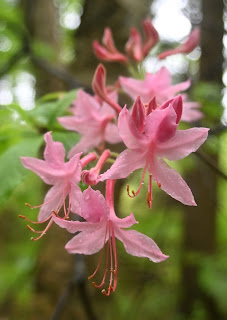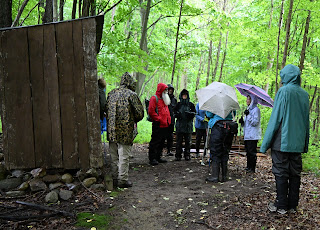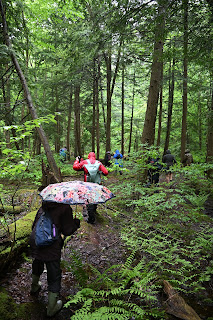
A National Natural Landmark with a Sphagnum bog and floating bog cradled by glacial drumlins, Zurich Bog covers 650 acres in Arcadia, NY. Anytime is a great time to enjoy this Bergen Swamp Preservation property. Based on past visits to Zurich Bog we are likely to see: Pitcher Plants, Lady Slippers, Cucumber Root, Trillium, Foam Flowers, Mayapple, Blood Root, several varieties of fern, Partridge Berry, Gold Thread, Ginseng, Solomon Seal, Sundew, tulip trees, Marsh Marigolds, and more.
It was a very wet day at the bog when 16 of us met at 10 AM. With boots and rain gear we ventured in for a wonderful adventure. Jimmy Johnson gave us information about Zurich Bog and about their efforts to manage the Hemlock Woolly Adelgid. Donations by way of membership to the Bergen Swamp Preservation Society to help afford mitigation efforts are appreciated. See Information from one of our members after the images.
(my apologies that the images did not load in the correct order - Laura)
 |
| Our leaders of the day. Fred, Bruce, Jimmy. |
 |
| native azailia |
 |
| Labrador tea |
 |
| Labrador tea |
 |
| along the boardwalk |
 |
| blueberry behind, huckleberry up front |
 |
| huckleberry |
 |
| sundew |
 |
| pitcher plant flower |
 |
| star flower |
 |
| miterwort |
 |
| sarsaparilla |
 |
| The group below is looking at the HWA above. |
 |
| The Plantman discusses Spicebush |
 |
| Plantman's favorite tree |
 |
| virginia waterleaf |
 |
| May Apples |
 |
| ferns, jewel weed, marsh marigolds |
 |
| swamp saxifrage |
 |
| Wet water avens |
 |
| jewel weed and jack in pulpits |
 |
| early meadowrue and friends | |
 |
| red marks indicate HWA mitigation efforts |
 |
| colony of Jack in the Pulpits |
 |
| pitcher plant flower |
 |
| partridge berry |
 |
| Canada Mayflower |
 |
| Starflower |
 |
| False Solomon's Seal |
 |
| Trillium - past bloom |
 |
| Labrador tea, pitcher plant, Royal fern |
 |
| Pitcher plant on Bog |
 |
| royal fern on bog |
 |
| Cucumber Root |
 |
| twayblade orchid |
 |
| eyelash fungi | |
Update on Hemlock Woolly Adelgid (HWA) in Zurich Bogto the Bergen Swamp Preservation Society
by Shelley Walker
Eastern Hemlock trees are the sentinels of the forest. Tall and long-lived, their shallow roots and lofty canopy offer many essential services: shade, clean and cool water, food, shelter, and erosion prevention. However, the invasive Hemlock Woolly Adelgid (HWA) poses a severe threat, jeopardizing their health and those who depend on them for survival.
The Bergen Swamp Preservation Society, in collaboration with PRISM and experts from Cornell Extension, is actively working to protect Hemlock trees. This spring, we've been scouting hemlock stands, marking infected trees, and tracking the spread of HWA. Last year, thanks to grant funding from the NYS Department of Environmental Conservation, we hired a licensed pesticide applicator, Zeb. We treated 2,558 trees with Imidacloprid, a chemical that, although slow-acting, effectively controls HWA and continues to protect the trees for 4-7 years. Treated trees are tagged with a number and receive a red circle towards the bottom of their trunk. Constant monitoring is vital, and we plan a second round of treatments this year to ensure long-term success.
The entire population of Hemlock Woolly Adelgids are females, and each lays hundreds of eggs yearly, protected by a waxy cotton pouch. With no natural predators, you can imagine how quickly their population can devastate a forest. Spraying alone cannot effectively control the infestation. The Bergen Swamp Preservation Society is hopeful that Zurich Bog will be a good candidate for biological controls like Laricobius beetles (Laricobius nigrinus) and Silver flies (Leucopis sp.), which naturally prey on HWA. The predators have been used in New York for several years, are establishing themselves, and show promise. They are released strategically to control HWA populations by eating eggs and larvae during both generations.
Additionally, exciting research is being done to cultivate HWA-resistant hemlock. Scientists noticed that some trees “linger” while others in the stand die off. By collecting seeds from resilient trees and growing them in test plots, we may be able to seed the forest with these hardy varieties, securing the biodiversity provided by hemlock ecosystems.
Through close monitoring, continuing education, and chemical control, we aim to preserve the Eastern Hemlock forest of Zurich Bog for generations to come. Support our efforts by becoming a Bergen Swamp Preservation Society member to contribute to our conservation efforts and engage with a like-minded community dedicated to making a lasting impact on this National Landmark.

















































































































